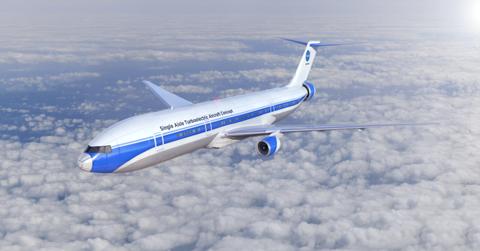NASA Aims For Aviation Renaissance With Fuel Efficient Next-Gen Aircraft
NASA's latest development in their series of next-generation aircraft is the concept of a modified engine that creates more thrust to increase fuel consumption. Further testing will be done over the next 12 months.
Updated Nov. 10 2017, 3:09 p.m. ET
While it doesn’t get as much attention as the evolution of vehicles, NASA have been working on the improvement of aircraft travel. They’ve developed a series of X-planes that tackle various limitations of today’s industry. One of the latest concepts is an aircraft that reduces fuel consumption.
Called the Single-aisle Turboelectric AiRCraft, the concept plane features a different boundary layer than conventional airplanes. It combines turbofan jets with a boundary-layer ingesting engine. Air that flows along the body of these aircrafts is collected by these giant fans and converted into thrust, which is known as the STARC-ABL concept.
These large fans are powered by two separate underwing engines that provide up to three megawatts of energy for the boundary-layer ingesting engine. It’s crucial for the engine to have plenty of power as it’s responsible for 20 percent takeoff power and 45 percent cruise power. According to NASA, the engine’s abilities could save 10 percent of fuel consumption.
Development has taken place at NASA’s Glenn Research Center in Cleveland, Ohio, and lead by Jim Felder and Jason Welstead. The concept aircraft is similar to a Boeing 737-800. According to their study, they could alter the shape of the body to provide even further thrusting ability and efficiency.
NASA’s Aviation Horizons initiative will also be looking at other aspects for the next generation, such as a supersonic passenger plane. They’ve been working on supersonic travel for decades, but it’s been banned in the United States since 1973 due to the loud boom it creates. This can obviously cause numerous issues such as breaking glass in buildings and alarming farm animals.
Since the loud noise is the biggest issue, NASA has been working on the aptly named Quiet Supersonic Technology (QueSST) aircraft concept. The planning lead of the project, David Richwine, told US News in October that success will lie in how it creates lift with the long, thin shape of the body and higher-placed wings. Instead of a sonic boom, “you get much more like a ‘thump’ sound.”
Further testing will need to be done with the STARC-ABL and QueSST concepts, including weight compensation and safety procedures, over the next year. Flight tests for the QueSST could take off as early as 2021. NASA is targeting their next-generation aircraft, either hybrid or turboelectric, with eco-friendly features to be in the air by 2037.
"During the 12-month cycle, we'll work with the teams to take a deep dive into their hybrid and turboelectric aircraft concepts," Amy Jankovsky, NASA's Advanced Air Transport Technology subproject manager, told New Atlas. "These concepts will provide in-depth, detailed analyses of the propulsion and electrical systems, and we will recommend technology development paths for their concepts."
